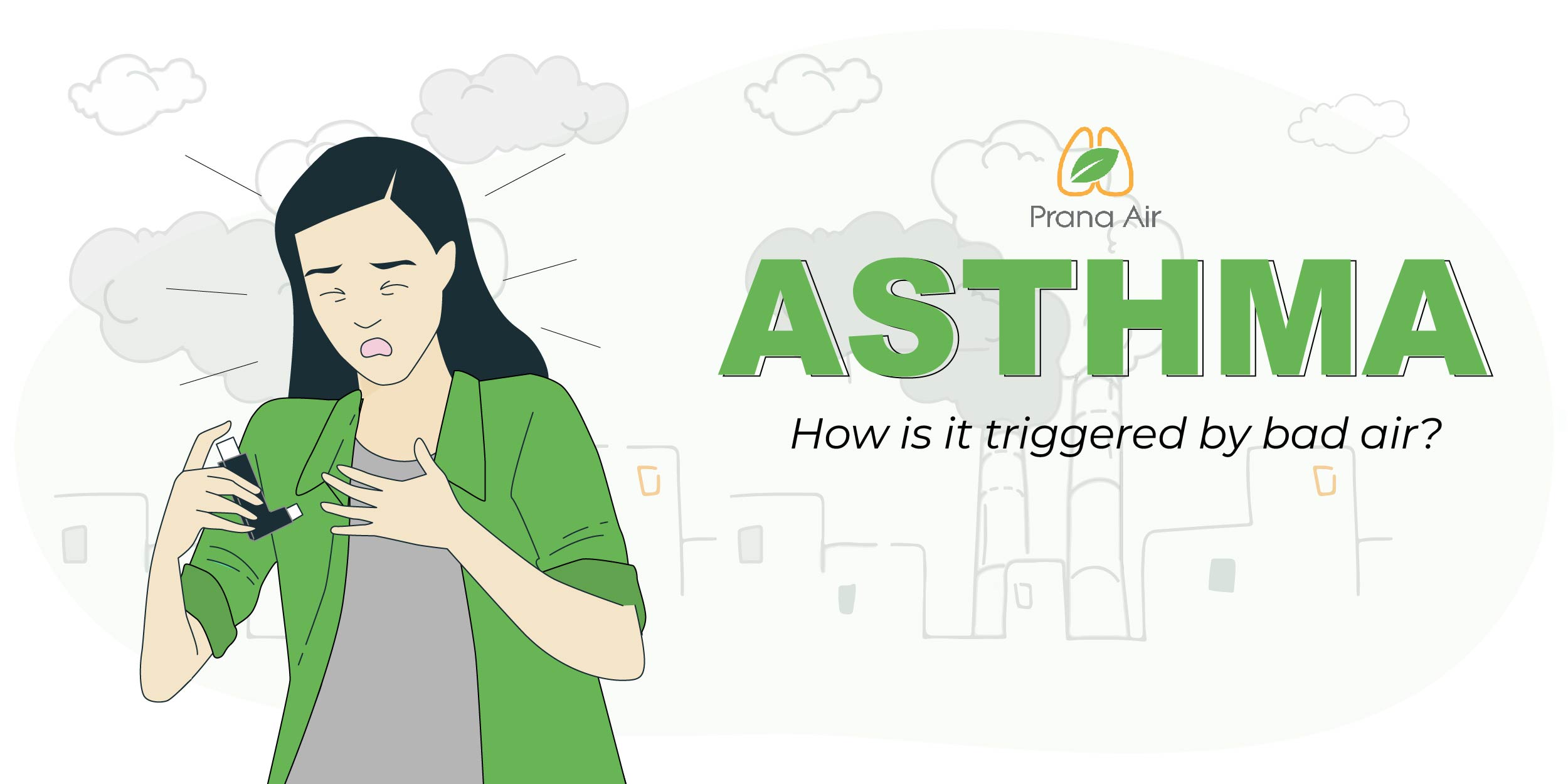What is Asthma?
Asthma, commonly referred to as bronchial asthma, is a treatable disorder in which the airways narrow and swell, making it difficult to breathe. Shortness of breath and a wheezing sound are signs of airway constriction. People who have asthma may see that sometimes they are breathing perfectly fine, like a regular, healthy person, but other times they will have extreme shortness of breath and terror. This occurs when their asthma attacks occur, causing the airways to narrow and get smaller. The most frequent causes of inflammation in asthmatic patients’ airways include air pollution, allergens, infections, mould, pollen, etc. Poor air quality is the outcome of all these factors. As a result, asthma is impacted by poor air quality.
Around 300 million individuals worldwide are estimated to have asthma, with the prevalence rising by 50% every ten years, according to PubMed’s Global Burden of Asthma report.
Let us read about this in detail.
– What is an Asthma Attack?
A person will experience shortness of breath, an increased heart rate, and perspiration when their asthma is triggered by any of the aforementioned factors. His inability to breathe properly prevents his blood from carrying enough oxygen to his vital organs, such as the lungs, brain, and so forth. His illness will worsen as a result, and he may need to see a doctor. An asthma attack is the sudden induction of asthma symptoms and deterioration of the patient’s health. An asthma attack causes the symptoms of the condition to become unbearable.
Symptoms of Asthma
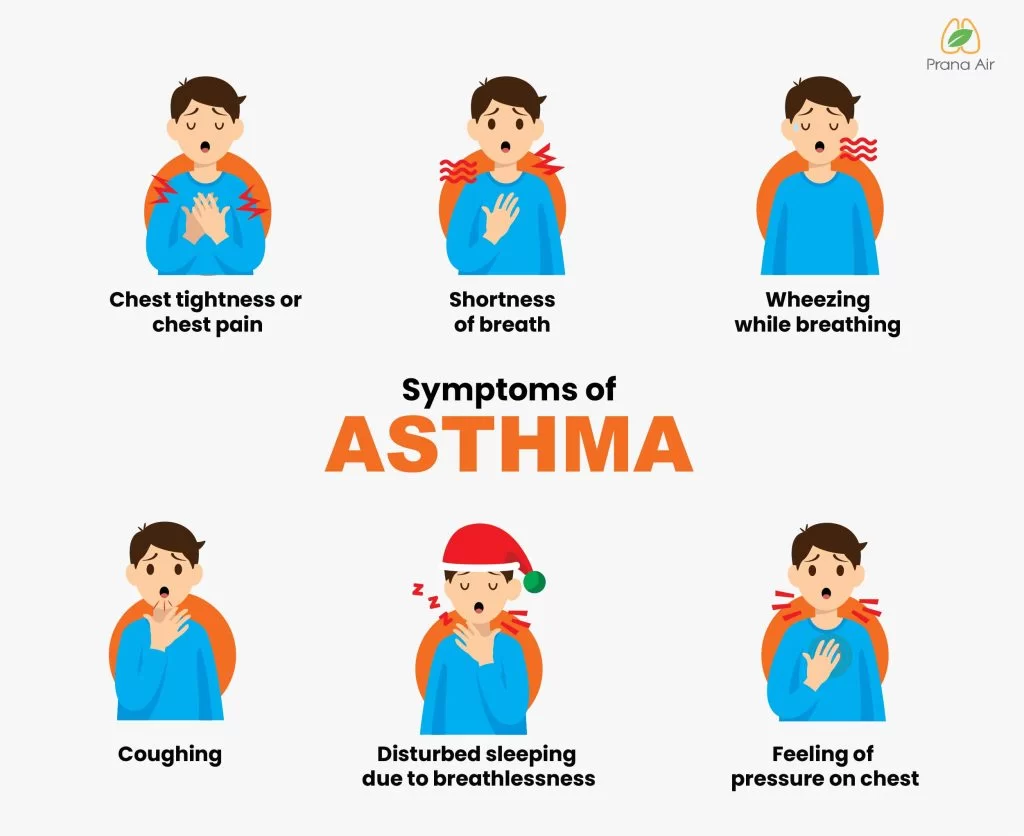
A dangerous lung disorder called asthma may prevent you from performing everyday duties. Asthma patients frequently experience the following symptoms:
- Chest tightness or chest pain
- Extreme shortness of breath
- Wheezing while breathing
- Coughing or wheezing attacks
- Disturbed sleeping due to breathlessness
- Feeling of pressure on the chest
Not all of these symptoms necessarily indicate that you have asthma. During asthma attacks, you may experience one or more of these symptoms alone or in conjunction with others. Although there is no known cure for asthma, it can be managed by avoiding the triggers, such as poor air quality nearby.
Who is more susceptible to Asthma?
Asthma can strike anyone at any age. Asthma is more likely to develop in people who are exposed to tobacco smoke, whether it comes from third- or second-hand smoke. Residents of a given location are impacted by the air quality in that area. Asthma is impacted by poor air quality, which may also make people’s diseases worse and make other respiratory issues worse.
Top Triggers of Asthma and how to avoid them
An asthma trigger is something that makes asthma worse. The airways’ muscles tighten or strain, producing more mucus. As a result, it could induce breathing problems by narrowing the airways. The things that cause asthma can change over time and vary from person to person. Avoid and get rid of these reasons if you want to stop asthma episodes and keep it under control. There are several different factors that might cause asthma. These are listed below:
One of the main asthma causes is air quality. Like the common cold, asthma is a non-transferable illness that cannot be spread from one person to another through the air. However, there are a lot of triggers that are carried by the air and may harm asthmatic people. Air can carry allergens including pollen, tobacco smoke, potent chemicals, and strong odours. As a result, an asthma patient's health is greatly influenced by the quality of the air. Asthma is impacted by bad air.
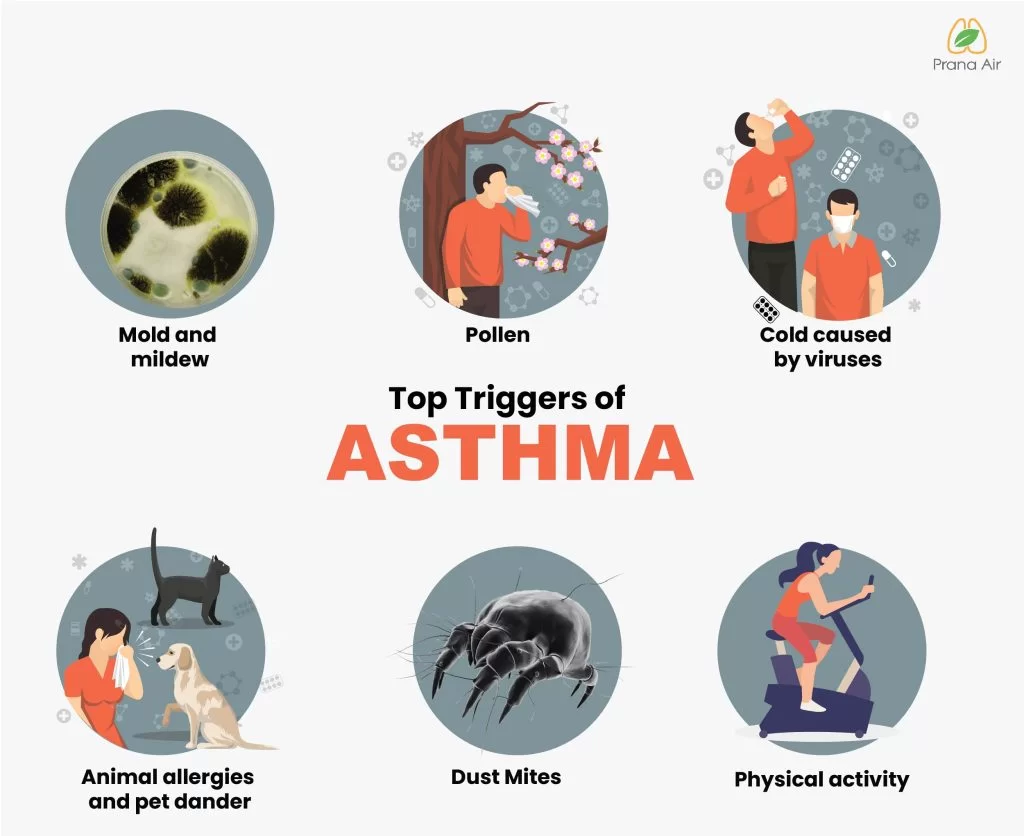
1. Outdoor Air pollution-
Asthma symptoms might deteriorate due to poor outdoor air quality. Attacks of asthma can also be brought on by poor air quality. Air pollution is the term used to describe the worsening of air quality brought on by a variety of factors, including manufacturing emissions, open waste burning, automotive emissions, wildfires, and many more. In the event that you have asthma and the air quality outside is poor;
- Avoid your outdoor time.
- Do not exercise outside.
- If you are stepping outside, make sure to carry your medicines and an anti-pollution mask with you.
2. Mold and mildew-
In environments with high humidity, mould can grow. Both indoors and outside are where you can find it. With asthma, mould can make breathing difficult. Even if you are not allergic to mould, it might still cause asthma attacks. An allergy to outdoor mould frequently causes severe asthma episodes and the need for extra medicine when outdoor mould levels are higher in the spring and fall.
Have a plan in place to manage your asthma during these times if you are allergic to outdoor molds.
3. Pollen-
It comes from weeds, grasses, and trees. In the spring, summer, and fall, it blooms. Pollen exposure may be related to the deterioration of asthma.
- During this time, following the instructions on your prescription can help you keep your asthma under control and prevent episodes.
4. Indoor air pollution and irritants-
Smoke, offensive smells, and indoor air pollutants including PM2.5, CO, CO2, etc. are all irritants. The sensitive airways may become allergic to these irritants and have a response.
- Steer clear of smoking, aerosols, and strong odors.
- A room should have adequate ventilation if it is subject to these irritants.
5. Cold caused by viruses-
Colds caused by viruses are a common asthma trigger. Cold viruses can make the swelling inside the airways worse. The two seasons where catching a cold is most likely to happen are winter and fall.
Wash your hands frequently to aid in preventing this.
6. Animal allergies and pet dander-
Asthma is frequently brought on by virus-based colds. As a result of cold viruses, the swelling within the airways may worsen. The months that colds are most likely to occur are winter and fall.
- Pets should not be allowed in bedrooms.
- Limit the pet’s frequent visits to the house.
7. Dust Mites-
Dust mites can be found on furniture covered in cloth, rugs, and bed sheets.
- Once every week, wash the bedding and dry it in a hot dryer.
- If you have a dust mite allergy, cover the mattress with a dust mite protector.
8. Physical activity-
Working out or vigorous exercising may cause heavy breathing and asthma attacks.
- Consult your doctor on which exercises you can and cannot do.
- Warm-up and Cool-down before activity.
9. Weather-
As discussed above, weather variations may contribute to the onset of asthma attacks.
- Staying away from and avoiding asthma triggers aids in asthma control and may result in less medication use.
How bad air quality affects Asthma?
A person with asthma may be impacted by the quality of the air both indoors and outside. This can include exposure to the environment, tobacco use, and even things like car pollution. Some of the most frequent triggers include ozone, often known as smog, and particle pollution, namely PM2.5 (particles with a size of 2.5 microns or less) and PM10 (slightly larger than PM2.5 but five times smaller than a human hair).
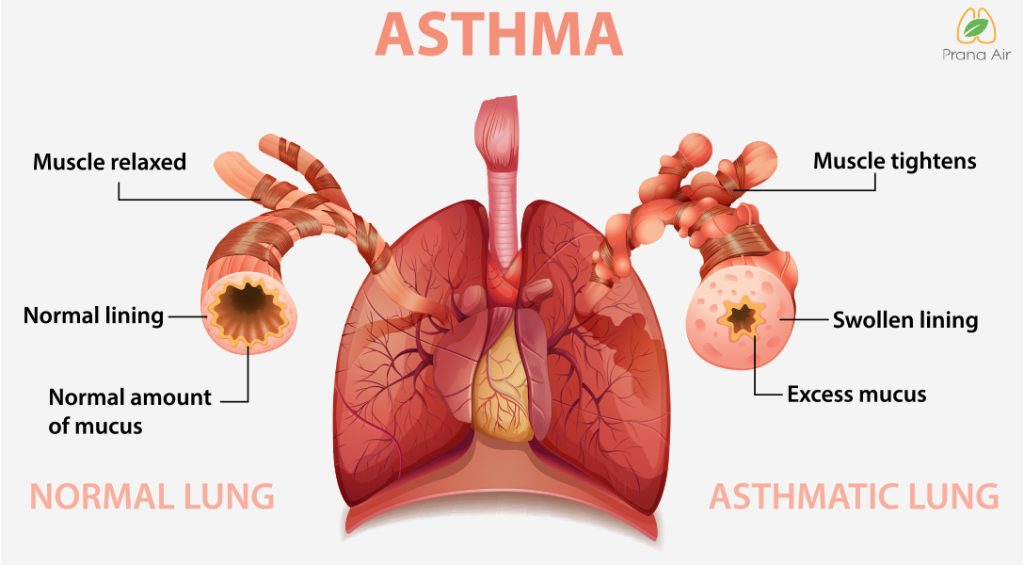
You can use the Air Quality Index, often known as the AQI, to forecast the conditions outside and prevent asthma triggers when you walk outside. The indoor trigger pollutants can also be tracked, and you can use the tracked data to manage and steer clear of these pollutants.
Healthy people are affected by air pollutants and poor air quality, but those who suffer from respiratory conditions like asthma and allergies may also be negatively impacted. They have the potential to aggravate asthma and function as triggers.
How does it affect children?

Particularly if there is a family history of asthma, children are more likely to develop asthma. Asthma affects one in ten children in India, where it is the most common chronic illness. According to the Global Asthma Report 2018, of India’s 1.31 billion people, 6% of children and 2% of adults have asthma. Due to their smaller airways, children are more severely affected by asthma than adults. Children with asthma frequently experience wheezing, coughing, tightness in the chest, and breathing problems, especially in the mornings and at night. Asthma is the most frequent cause of paediatric emergency room visits, hospital stays, and multiple missed school days.
Asthma symptoms in children can appear as young as age 5. They have developing lungs, so it’s important to recognise any signs, use preventative measures, and treat asthma carefully to avoid harming the developing lungs.
How can you determine whether you have asthma?
Wheezing and breathing difficulties can be brought on by a variety of respiratory conditions and disorders. You must therefore seek medical assistance to ascertain whether asthma, an allergic reaction, or another issue is to blame for your symptoms.
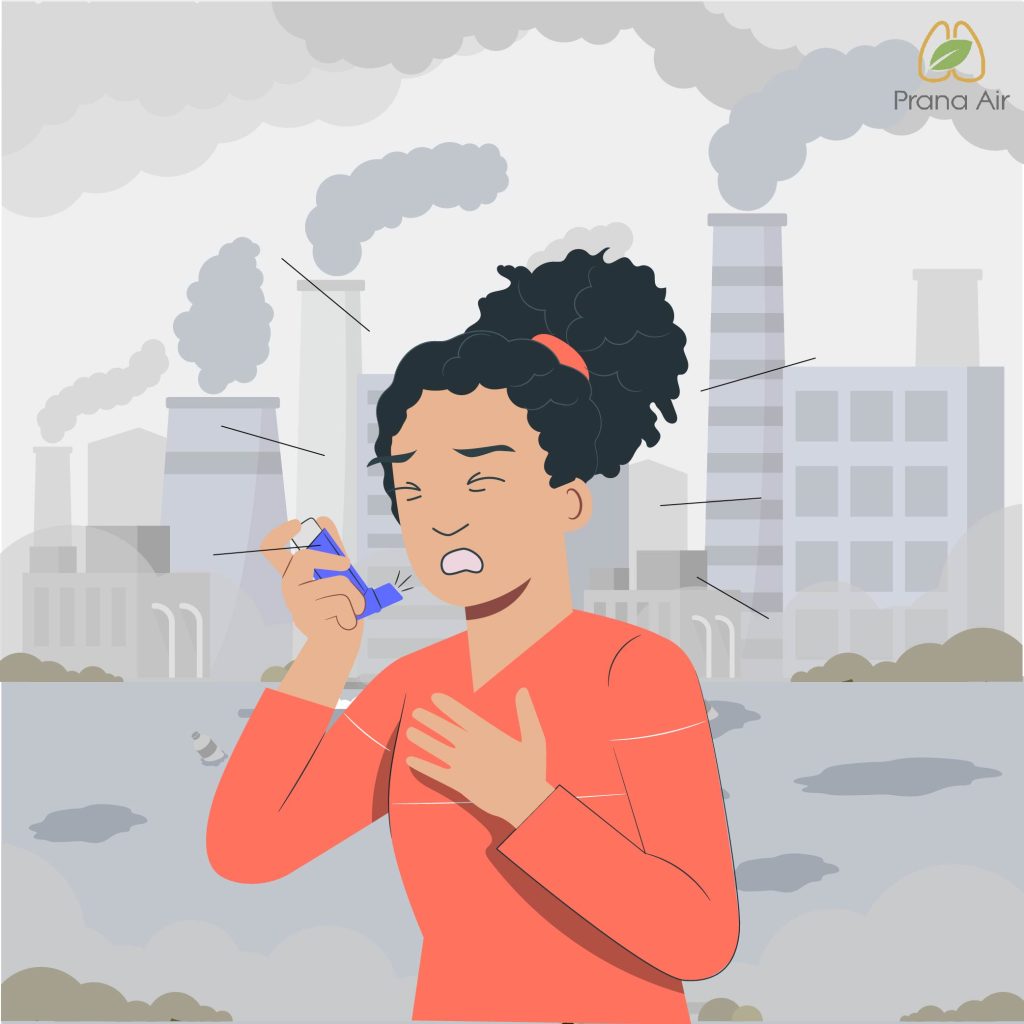
Frequent healthcare visits are directly correlated with poor air quality.
Persons with asthma and respiratory conditions are more adversely impacted by poor air quality than healthy people. They thus suffer more severe health effects. Poor air quality can cause respiratory problems and wheezing, which can lead to frequent ER and doctor visits.
When to get help?
You must speak with your doctor right away to receive urgent care and prompt medical attention:
- When you have persistent wheezing, severe breathing problems, or both, and they don’t go away after taking your existing medicine.
- Breathing is challenging because your airways are narrowed, and your condition may worsen if you are exposed to specific triggers.
- Whenever you are breathing when under stress or tension.
- When your asthma symptoms become more severe or new.
Must read: Maintain Healthy Air Quality Standard for Your Loved Ones at Home

